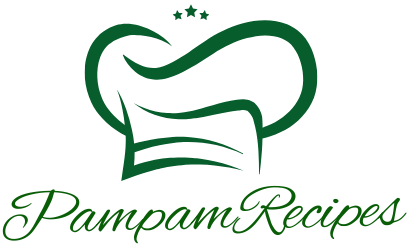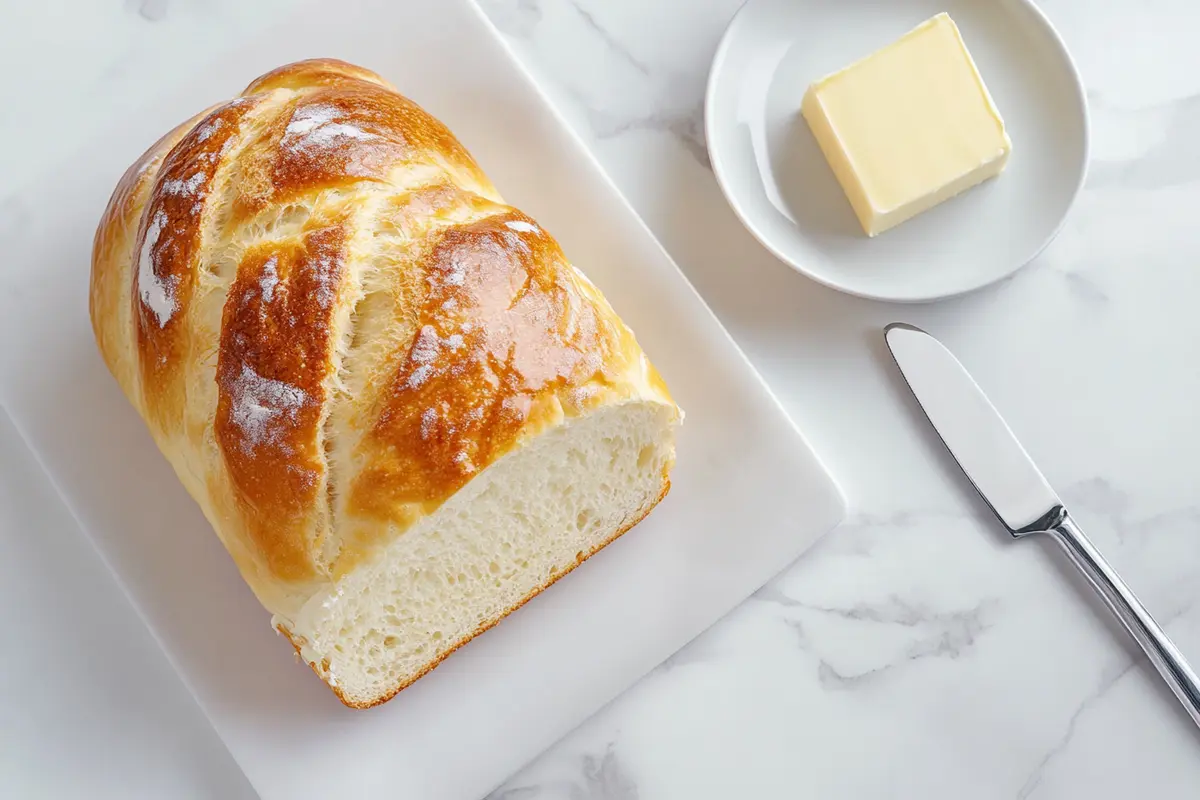Introduction: Why Milk Bread Is a Baking Must-Try
When it comes to bread, few varieties are as universally loved as milk bread. Known for its soft, pillowy texture and slightly sweet flavor, this bread has captured the hearts (and stomachs) of people worldwide. Whether you’ve had it in an Asian bakery or at home, its melt-in-your-mouth quality makes it irresistible.
In this article, we’ll explore everything you need to know about milk bread. From its unique origins to tips for perfecting it at home, we’ve got you covered. You’ll also find a detailed recipe, complete with step-by-step instructions and nutritional information. Let’s dive into the magic of making this versatile bread and bring bakery-quality results into your kitchen.
Introduction to Milk Bread
What Is Milk Bread?
Milk bread, often referred to as Hokkaido or Asian milk bread, is a type of enriched bread made with milk and butter. Its defining characteristic is its fluffy, light texture, which comes from the unique tangzhong method. This bread is popular in Japan, South Korea, and beyond, thanks to its ability to stay soft for days.
Unlike traditional white bread, milk bread has a slightly sweet and buttery flavor. It’s perfect for sandwiches, toast, or simply enjoying as is. Its versatility and delightful taste make it a go-to recipe for both novice and seasoned bakers.
Why Milk Bread Is Special
So, what sets milk bread apart from other breads? For starters, its tangzhong technique involves cooking a portion of the flour and water into a paste before mixing it into the dough. This step ensures the final loaf is incredibly tender and stays fresher longer. Plus, the enriched dough—thanks to milk, butter, and sugar—creates a luxurious texture that’s hard to resist.
Additionally, milk bread is wonderfully adaptable. Whether you’re craving a savory garlic loaf or a sweet cinnamon swirl, this bread serves as the ideal base for experimentation. With just a few adjustments, you can turn it into rolls, buns, or even dessert bread.
Ingredients for Milk Bread
Essential Ingredients
Making milk bread at home requires a few basic ingredients that come together to create its signature soft and fluffy texture. Here’s a list of what you’ll need:
For the Tangzhong Starter:
- Bread Flour (2 tablespoons): Provides structure to the paste.
- Milk (1/2 cup): Helps hydrate the flour and adds richness.
- Water (1/2 cup): Keeps the starter smooth and prevents dryness.
For the Dough:
- Bread Flour (2 ¾ cups): The foundation of the dough, creating elasticity and strength.
- Sugar (3 tablespoons): Adds a subtle sweetness.
- Salt (1 teaspoon): Enhances flavor and balances sweetness.
- Instant Yeast (2 teaspoons): Ensures a good rise for a light texture.
- Milk (1/2 cup, warm): Activates the yeast and contributes to the soft crumb.
- Unsalted Butter (4 tablespoons, softened): Adds moisture and a buttery flavor.
- Egg (1 large): Provides structure and richness.
Choosing Quality Ingredients
For the best results, always select high-quality ingredients:
- Bread Flour: Look for one with a higher protein content to achieve elasticity.
- Milk: Full-fat milk enhances the richness and softness of the bread.
- Butter: Use unsalted, fresh butter for a pure, creamy flavor.
- Yeast: Opt for instant yeast to save time and ensure reliable rising.
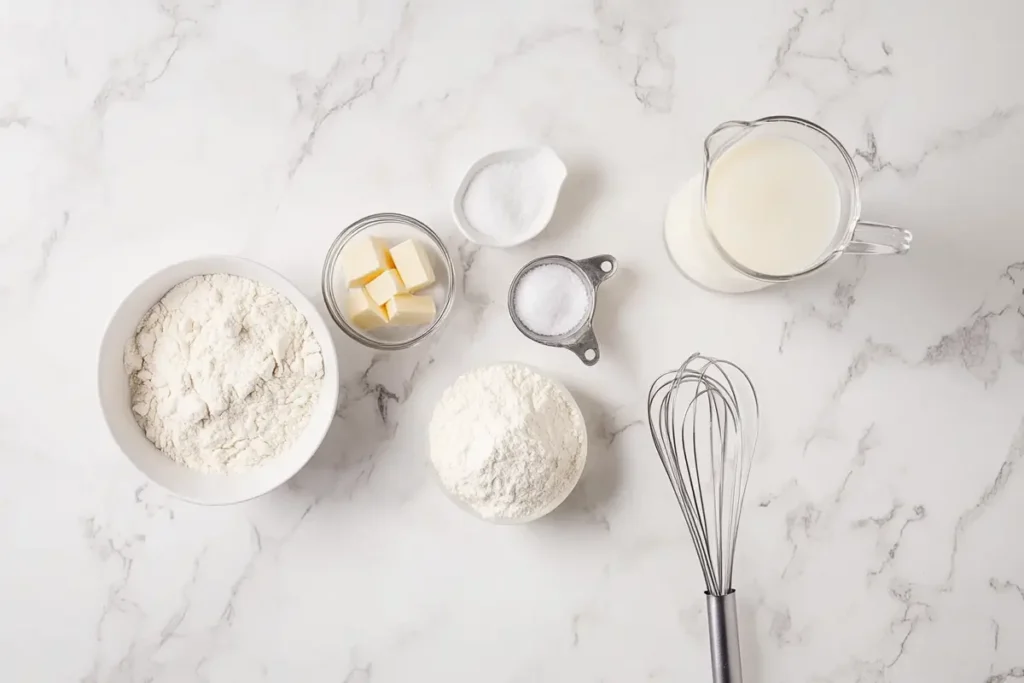
How to Make Milk Bread
1: Preparing the Tangzhong Starter
- Combine Ingredients: In a small saucepan, mix 2 tablespoons of bread flour, 1/2 cup of milk, and 1/2 cup of water.
- Cook the Paste: Heat the mixture over medium-low heat, whisking constantly until it thickens into a smooth, paste-like consistency. This usually takes 3–5 minutes.
- Cool the Starter: Remove the tangzhong from the heat and let it cool to room temperature before adding it to the dough.
2: Mixing the Dough
- Combine Dry Ingredients: In a large mixing bowl, whisk together bread flour, sugar, salt, and instant yeast.
- Add Wet Ingredients: Add the tangzhong starter, warm milk, softened butter, and egg. Mix until the dough begins to come together.
- Knead the Dough: Knead the dough on a floured surface for 8–10 minutes until it becomes smooth and elastic. Alternatively, use a stand mixer with a dough hook for 5–7 minutes.
3: Proofing the Dough
- First Rise: Place the dough in a greased bowl, cover it with a damp towel, and let it rise in a warm spot for about 1–1.5 hours or until it doubles in size.
- Punch Down the Dough: Gently punch down the dough to release any trapped air before shaping.
4: Shaping and Baking
- Shape the Dough: Divide the dough into three equal portions. Roll each portion into a rectangle, fold it into thirds, and roll it up into a cylinder. Place the cylinders side-by-side in a greased loaf pan.
- Second Rise: Cover the pan and let the dough rise again for 40–50 minutes until it puffs up.
- Bake the Bread: Preheat your oven to 350°F (175°C). Brush the dough with milk for a golden crust and bake for 25–30 minutes.
- Cool the Bread: Let the loaf cool in the pan for 10 minutes before transferring it to a wire rack to cool completely.
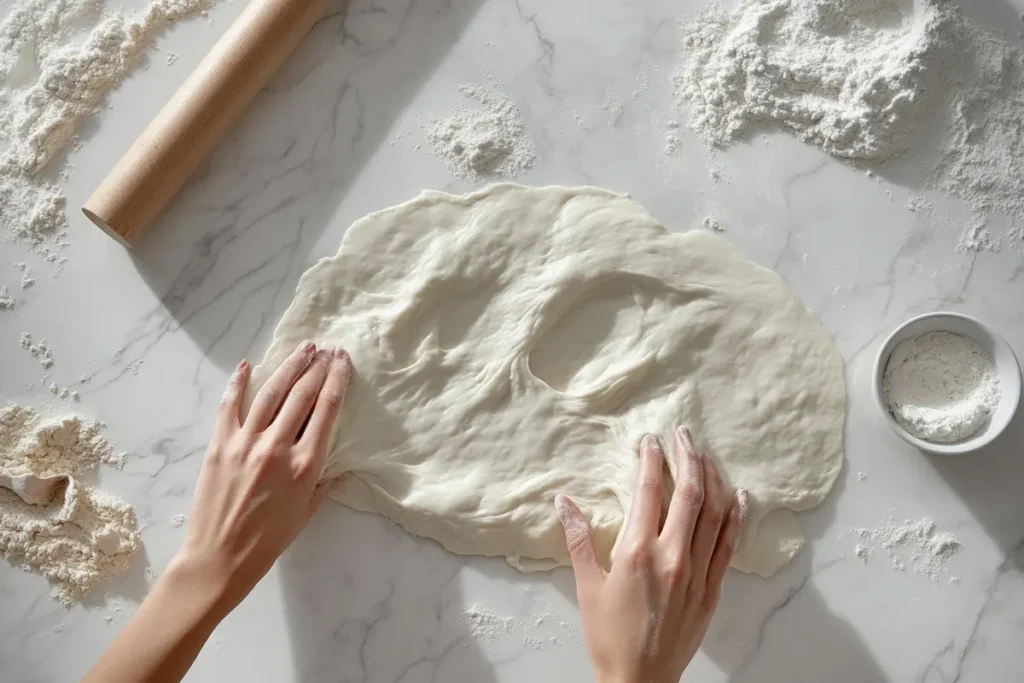
Need More Baking Inspiration?
For another delightful recipe, check out our marbled banana bread and bring more homemade treats to your table!
Nutritional Information for Milk Bread
Health Benefits of Homemade Milk Bread
One of the best things about making milk bread at home is the control you have over the ingredients. Unlike store-bought bread, which often contains preservatives and artificial additives, homemade bread allows you to stick to wholesome, natural ingredients. This makes it a healthier choice for you and your family.
Moreover, milk bread provides a good balance of carbs, proteins, and fats. The tangzhong method keeps the bread moist and light without requiring excess butter or oil, while the milk and egg add essential nutrients like calcium, vitamin D, and protein.
Nutritional Content Table
Below is the nutritional breakdown of milk bread per 100 grams:
| Nutrient | Amount (per 100g) |
|---|---|
| Calories | 250 kcal |
| Protein | 7 g |
| Carbohydrates | 42 g |
| Sugars | 8 g |
| Fat | 6 g |
| Sodium | 200 mg |
If you’d like to make your milk bread even healthier, try using whole wheat flour for added fiber or reducing the sugar for a lower-calorie option. However, keep in mind that substitutions may affect the bread’s soft texture.
Tips for Perfecting Milk Bread
Avoiding Common Mistakes
Even with a straightforward recipe, it’s easy to run into a few bumps along the way. Here are some tips to help you avoid common pitfalls when baking milk bread:
- Over-kneading the Dough: While kneading is essential, too much of it can make the dough tough. Knead until it’s smooth and elastic, but stop before it becomes sticky or overly stretchy.
- Skipping the Tangzhong Step: Don’t skip the tangzhong method—it’s the secret to milk bread’s softness and moisture. It’s worth the extra effort for bakery-style results.
- Under-proofing or Over-proofing: Getting the proofing time right is key. Under-proofed dough won’t rise properly, while over-proofed dough can collapse during baking. Aim for dough that doubles in size during the first rise.
Customizing Milk Bread for Flavors
One of the most exciting aspects of milk bread is its versatility. With a few simple tweaks, you can create a variety of flavors to suit any occasion. Here are some ideas:
- Sweet Variations: Add raisins, chocolate chips, or a swirl of cinnamon sugar for a dessert-like loaf.
- Savory Additions: Incorporate cheese, garlic, or fresh herbs into the dough for a savory twist.
- Seasonal Touches: Infuse the dough with pumpkin puree or matcha powder for a unique seasonal loaf.
Experimenting with different flavors is a fun way to make the recipe your own and keep your baking exciting.
Pro Tip for a Golden Crust
For a beautifully golden crust, brush the dough with milk or an egg wash before baking. This simple step adds a glossy finish and enhances the bread’s overall appeal.
Explore More Recipes
For more creative baking ideas, explore our crumbi cookie recipe for another fun and delicious treat to try at home.
Frequently Asked Questions (FAQs)
1. What Is the Tangzhong Method?
The tangzhong method is a unique technique that sets milk bread apart from other types of bread. It involves cooking a portion of the flour and liquid (milk and/or water) into a thick paste before adding it to the dough. This method helps the dough retain moisture, resulting in bread that stays soft and fluffy for longer periods.
Tangzhong also makes the bread easier to knead and less prone to drying out. While it might seem like an extra step, it’s the secret to achieving bakery-quality milk bread at home.
2. Can I Make Milk Bread Without Tangzhong?
Yes, it’s possible to make milk bread without the tangzhong method, but the results may vary. The bread might not be as soft or stay fresh as long. If you want to skip tangzhong, try increasing the amount of milk or butter in the recipe to compensate for the missing moisture.
For a simplified version, you can also follow recipes designed specifically for no-tangzhong bread, though they may not have the same signature texture.
3. How Long Does Milk Bread Stay Fresh?
One of the benefits of milk bread is that it stays fresh for several days due to its enriched dough and the tangzhong method. When stored in an airtight container or wrapped tightly in plastic wrap, it can last up to 3–4 days at room temperature.
If you’d like to keep it longer, consider freezing it. Slice the loaf before freezing so you can easily thaw individual pieces. When you’re ready to enjoy it, toast the slices lightly, and they’ll taste as fresh as when they were baked.
4. Can I Use Whole Wheat Flour for Milk Bread?
Yes, you can use whole wheat flour to make a healthier version of milk bread. However, because whole wheat flour is denser and absorbs more liquid, you’ll need to make a few adjustments:
- Increase the liquid slightly to ensure the dough remains soft.
- Combine whole wheat flour with bread flour (e.g., 50/50) to maintain the fluffy texture.
This variation offers added fiber and nutrients while still delivering a soft and delicious loaf.
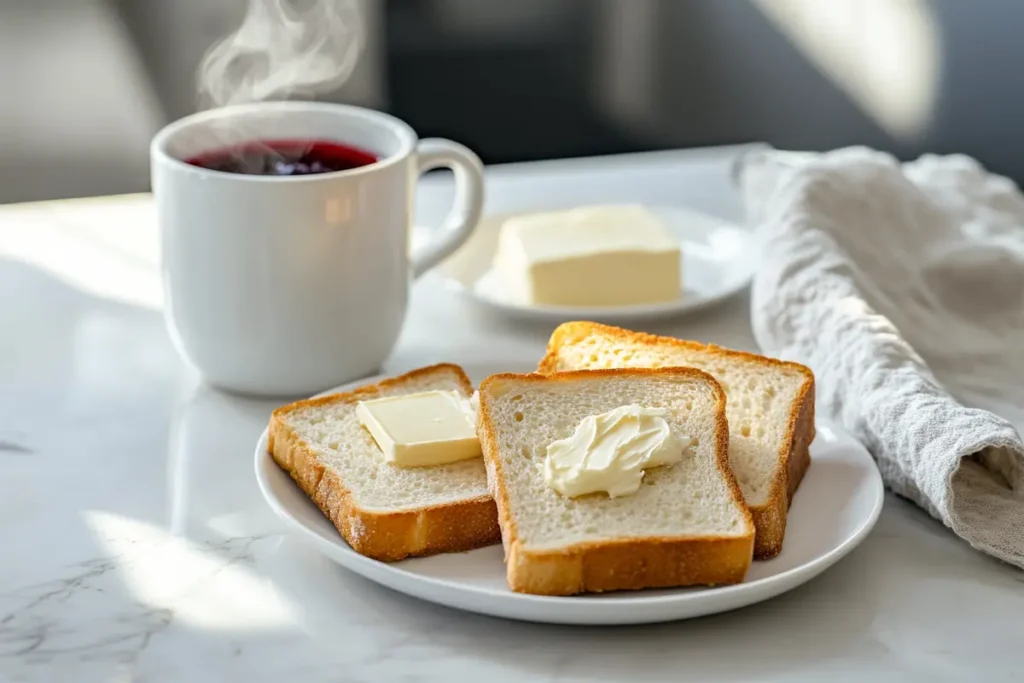
Conclusion – Why You Should Try Making Milk Bread
A Timeless and Versatile Recipe
Milk bread is more than just a baking project—it’s a recipe that brings warmth and comfort to your table. With its soft texture, subtle sweetness, and endless versatility, this bread fits into every part of your day. Whether it’s part of breakfast, lunch, or a sweet snack, it’s always a delight.
The tangzhong method may seem intimidating at first, but once you’ve tried it, you’ll understand why it’s worth the effort. This simple step elevates the bread, giving it a professional-quality softness and flavor that rivals any bakery loaf.
Encouraging Experimentation
One of the greatest joys of making milk bread is its incredible adaptability. For instance, you can keep the recipe classic, or, alternatively, let your creativity shine by experimenting with a variety of flavors and fillings. For a dessert-like treat, you might add chocolate chips, while swirling in pesto could give the bread a savory twist. Furthermore, sprinkling sesame seeds on top can enhance both the flavor and texture, making your loaf even more delightful.
Even if you’re new to bread-making, milk bread is a forgiving recipe that’s perfect for beginners. Each step builds your confidence, and the end result is always rewarding. It’s a recipe you’ll come back to time and again.
Try Another Delightful Recipe
If you’ve enjoyed making milk bread, why not explore other homemade recipes? Check out our best peach crumble recipe for another fun and tasty baking project that pairs wonderfully with your bread.
Common Mistakes to Avoid When Making Milk Bread
1. Over-Kneading the Dough
One of the most common mistakes when making milk bread is over-kneading the dough. While it’s important to knead until the dough becomes smooth and elastic, kneading it for too long can make it tough. This happens because overworking the dough can cause the gluten to become too developed, resulting in a denser loaf.
To avoid this, knead the dough just until it feels soft and slightly tacky. If you’re using a stand mixer, 5–7 minutes of kneading should be enough. Remember, dough should be slightly elastic but not overly stretched.
2. Not Letting the Dough Rise Enough
Another mistake is not allowing the dough to rise sufficiently. The first rise, or bulk fermentation, is critical to achieving the light, fluffy texture that makes milk bread so special. If you rush this step or don’t give the dough enough time to double in size, your bread will turn out dense and flat.
Make sure to give the dough time to rise in a warm, draft-free spot. A good rule of thumb is to let it rise for 1–1.5 hours or until it has doubled in size. Patience during this stage will pay off with a soft, airy loaf.
3. Not Baking at the Right Temperature
Baking at the wrong temperature can lead to uneven results. If the oven is too hot, the outside of your milk bread might brown too quickly, leaving the inside undercooked. If the oven is too cool, the bread might not rise properly, and the crust may remain pale and soft.
Ensure your oven is preheated to 350°F (175°C), and use an oven thermometer to check the temperature. If you find that the top of the loaf is browning too fast, cover it with foil for the remaining baking time.
4. Forgetting to Cool the Bread Properly
Once your milk bread is out of the oven, resist the temptation to slice into it right away. Cutting into hot bread can cause it to become gummy and misshapen. Instead, allow the loaf to cool for at least 10 minutes in the pan, and then transfer it to a wire rack to cool completely.
This helps the bread set properly, and you’ll be rewarded with a perfect texture when you slice it.
Why Milk Bread Is Worth Trying
A Comforting and Versatile Bread
Making milk bread at home is an incredibly rewarding experience. Its soft, pillowy texture and subtly sweet flavor make it a comforting treat for any time of day. Whether you’re enjoying it with jam for breakfast, using it for sandwiches at lunch, or making a batch of rolls for dinner, milk bread fits seamlessly into any meal.
What’s more, this bread is versatile enough to be customized with your favorite flavors. Add cinnamon for a spiced version, or swirl in some chocolate chips for a fun twist. The possibilities are endless!
A Recipe for Everyone
Milk bread isn’t just for experienced bakers—its forgiving nature makes it perfect for beginners. The dough is relatively easy to handle, and even if you make a small mistake, the bread still turns out delicious. With just a few ingredients and some patience, you can create a loaf that looks and tastes like it came from your favorite bakery.
Moreover, making milk bread at home allows you to avoid preservatives and additives found in store-bought bread. You can ensure that your bread is made with fresh, high-quality ingredients that suit your dietary preferences.
Creating Memories in the Kitchen
Baking milk bread is also a wonderful way to create lasting memories with your loved ones. Whether you’re baking with your children, friends, or on your own, there’s something special about the process of making bread from scratch. The smell of freshly baked bread filling your home is a comforting experience that brings joy to everyone.
A Great Addition to Any Meal
Finally, milk bread is an ideal choice for almost any occasion. Whether you’re hosting a brunch, a family dinner, or simply enjoying a quiet breakfast, this bread is a great addition. It’s light, flavorful, and perfect for pairing with a wide range of spreads, from butter and honey to avocado and eggs.
For More Delicious Recipes
If you’re looking to try more homemade baked goods, don’t miss out on our banana bread recipe. It’s another delightful treat that’s simple to make and perfect for any occasion!
